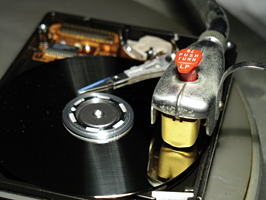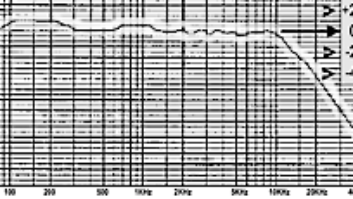
This method of getting a warm analog sound from your hard disk is not recommended.
Earlier this year, I interviewed engineer Richard Dodd (see “Tech’s Files” in the May 2008 issue), who reminded me that on many a revered recording, signal chains were chosen from a short list of “what we have,” “what we have left” or “what we have working.” The updated version of that is perhaps “what we have this century” — meaning, the luxury of many options, perhaps too many.
This column focuses on the Discipline of Obstacles. Such obstacles might include — as an exercise — imposing a limit on outboard gear or plug-ins, turning the limitations of vinyl into a basic ear-training session and being creative by using simple tools to do big things.
STOP IN THE NAME OF…
At one time or another, all of us have become addicted to compression. But with the dynamics police monitoring my every move, I’ve been instructed to direct my mouse away from the plug-ins menu and take advantage of one very basic tool — automation!
Compression can make a mix very dense, which can be fatiguing. But assuming a performance was played dynamically, applying compression can remove dynamics that must be written back in with automation. It seems simple enough, doing the automation first creates more sonic real estate; any compression that is applied afterward will be more effective and less fatiguing.
ORANGES AND LEMONS
Along with a near-constant interest in retro gear comes a renewed interest in vinyl. Can we apply an analog aesthetic that nurtures the appreciation of recorded music? My recollection of playing records in the ’60s and ’70s was that the top end was a bit understated — I was always reaching for the treble. Some of that was simply the way many recordings sounded and that records were mixed/mastered for the technology of the day.
In defense of mastering engineers, analog playback involves many things beyond their control. By contrast, digital is much more consistent.
BACK IN THE DAY
Back when records and tapes were the “final products,” filling the grooves with just the right balance of bass and treble was a challenge. Short recordings could be louder on disc than longer ones. In addition, the groove and stylus marriage does not tolerate low-frequency phase anomalies (panned toms in particular) or excessive sibilance.
As a fledgling engineer, I never worried much about sibilance until doing an overdub session at Sigma Sound in New York. Engineer Carla Bandini asked why I wasn’t using a de-esser/high-frequency limiter; she heard something I didn’t. Sigma’s New York and Philadelphia studios were close to Frankford-Wayne Mastering, giving their engineers a more intimate understanding of what could be transferred to disc.
Keep in mind that sibilance level is nearly a constant compared to the dynamic range of the voice itself: The softer the vocal, the more pronounced sibilance could be. And while digital recording makes high-frequency limiting technically unnecessary, doing so can smooth the puzzle pieces of a multichannel recording into a more homogenous blend. It’s not necessary to be heavy-handed — adjust until you can hear it and then back off a little.
MID/SIDE = SUM-DIFFERENCE
One of the ways to get inside a stereo mix is with sum and difference processing — sum being left plus right (mono) and difference being left minus right:
Encode: Sum = L + R Difference = L – R
Decode: 2L = (L + R) + (L – R) 2R = (L + R) – (L – R)
These simple equations show how a stereo recording is converted into its sum and difference equivalent and back again. Notice how the double-negative in the bottom equation becomes addition.
The funny thing about sum and difference processing is that the basic math to explain the encoder/decoder is simpler than setting up a workstation template. (See table, page 76.) That said, the simple math examples treat the left and right channels as if they were DC (direct current) signals. We all know that a stereo pair — as drum overheads, piano or room tracks, etc. — will have complex phase information. The math could be expanded to explain the relationships, but I’ll spare you that detour.
Start by summing a mix to mono. Any tracks panned exactly up the middle will be 6 dB louder than the hard-panned tracks. For the difference signal, one channel’s polarity is reversed so that “adding” becomes subtraction — everything panned exactly up the middle will disappear.
Listening to the difference channel, the most obvious “remainder” is what’s panned — stereo reverb and effects — and for analog consoles, how much stuff is not panned as straight up the middle as you’d like. Dolby Pro Logic derives the rear-channel surround signal the same way.
An abundance of out-of-phase, low-frequency information in the difference signal translates into wasted energy that can keep a mix from being tight and punchy. Trimming such “fat” should happen during the mix process on individual tracks, but if it doesn’t, don’t be afraid to dial in a highpass filter.
M/S TO STEREO
To reconstitute, bring the difference mix up on two faders — panning hard-left and -right — and then reverse polarity on one channel strip. Listening to this alone will tweak your ears a bit because the signals are 180 degrees out of phase (in mono, they will cancel), but as the sum/mono channel is gradually faded in, the mix can be as wide or as “narrow” as you like. The same technique is used by stereo mics that employ two different capsules — a cardioid (for mid/sum) and a figure-8 (for side/difference).
During the decode process, the mix of mid and side allows the stereo width to be adjusted after the fact. In stereo, the left and right processing (EQ, dynamics) must be identical, but in sum and difference processing, inverse processing can be very powerful. In conventional stereo, it would be almost impossible to help a dark and buried lead vocal that is competing with very edgy, hard-panned guitars. In mono, the vocal will be 6 dB louder — that and a little creative EQ can help it stand out. Panned guitars are typically two non-exact parts, so they won’t be as loud. Meanwhile the vocal will be absent from the difference channel; a completely different EQ curve can make the guitars less edgy and less competitive.
Once the M/S is reconstituted as stereo, the balance between vocals and guitars should improve. Going too far is not a problem; you can always try again or mix the processed version into the original.
Great recordings and mastering are more than just balancing the mix and knowing what sounds good. One trick is knowing what used to be the delivery media’s limitations and treating digital like analog.
This summer, Eddie’s mixing a retro recording of ’60s and ’70s R&B. You can hear samples at www.tangible-technology.com.







